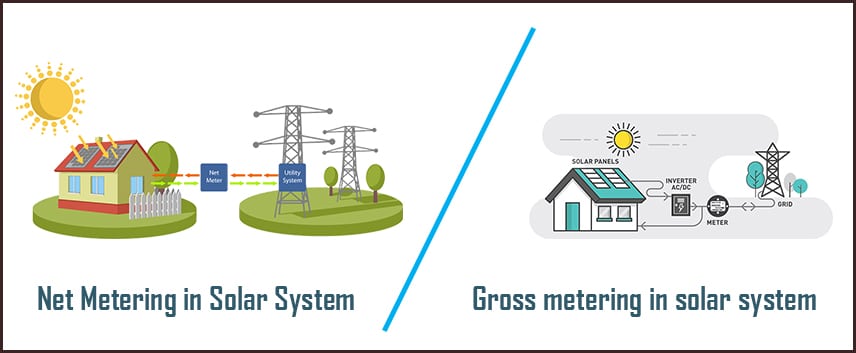Solar energy installation is widespread in Australia. We bet you are already aware of its fundamental operating concepts and outstanding benefits. What is less commonly known is ‘solar net metering’ and ‘solar gross metering’.
You may ask- ‘after installing a solar system, how does it calculate my energy bill?
What is net feed-in tariff and gross feed-in tariff?
Rest assured!
We will go in-depth of a solar metering system in this post; so that you’ll have a clear picture of how the solar energy billing works and which one would be a practical choice for your house.
Australia’s solar energy and metering systems:
Australia is among the top ten countries to utilize solar energy on a massive scale. Not only industries but Australian houses have turned solar in record numbers.
For generating solar electricity bills for a grid-connected PV system, Australia uses the following two types:
- Solar net metering
- Solar gross metering
Let’s discuss both one by one.
What is solar net metering?
Net Energy Metering or net metering is a way of offering a solar incentive in the form of credits when you send excess solar electricity to the grid.
These credits are usually a set price per kilowatt-hour.
How does it work?
A solar system is responsible for capturing sun rays and converting them into usable (AC energy) electricity to power up your house.
At times the very PV system produces surplus energy, more than what you usually need. Therefore, the additional solar electricity is fed back to the utility grid, and you get credits against this excess energy submission. In other words, it’s nothing but selling solar power back to the grid.
On the contrary, in some instances, the photovoltaic system generates energy less than your demands. As a result, you pull the power from the utility to fulfil your energy requirements.
So, how all the exporting and importing of electricity reflect in the utility bill?
For all the excess power fed in the grid, you get compensating credits. When you use electricity from the grid, you get charged for it. The energy bill looks something like the following equation:
Cost of utilized gird electricity – credits on excess energy submitted to the grid = final billing amount.
Furthermore, net metering allows you to know the amount of solar energy sent to the grid and the energy imported from the grid when the panels were underperforming. Meaning, you cannot figure out the following two things from the net metering energy bill:
- The total amount of energy produced by the photovoltaic system and
- The total amount of energy used by the home
One significant phenomenon to note here is that net metering is not the only way by which solar owners get compensated; however, it’s quite a common one.
What is gross metering?
As the name suggests, Gross metering is but feeding all the solar energy to the utility grid.
In gross metering, a PV system will export all the produced energy to the grid.
One obvious question arises here: How household energy requirements are met?
Your home uses the electricity from the grid at the same time when it transmits solar power back to the grid.
So how do you get charged?
You pay for the electricity you pulled from the gird, but also get the compensation from the utility company for all the energy you fed in the grid.
The gross metering lays out the energy usage and production stats clearly unlike net metering. You precisely get to know what amount of energy was sent to the grid by your PV system. Furthermore, the electricity bill also tells you the amount of grid power used by your house.
What will work best for you?
Metering policies vary from state to state. Some Australian states offer lucrative rates for gross metering while in others, net metering proves to be a better option. If your energy needs are not extraordinary, solar net metering could bring in comprehensive benefits and savings.
Feed-in Tariff rates across Australia
To learn in deep about Feed-In-Tariff FiT in Australia – state by state, please visit this report by Australian Energy Council AEC- https://www.energycouncil.com.au/media/12974/feed-in-tariffs-state-by-state.pdf
Not only will you get access to metering rates but also the other vital information surrounding it.
Conclusion
It’s crucial to understand the solar metering system before going ahead with the installation. We are sure this piece of information must have cleared all the doubts in your minds. Vista Electrical Controls are experienced, qualified solar panel installers in Perth.
We will assist you in the right direction to customize, finalize and choose the precise size of the solar system with the appropriate metering mechanism.
For further information, do not hesitate to call us – 1300181116 or drop us an enquiry at info@vistaelectricalcontrols.com.au


